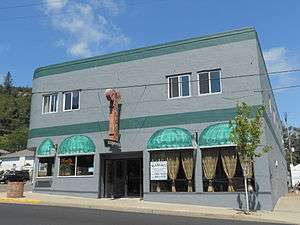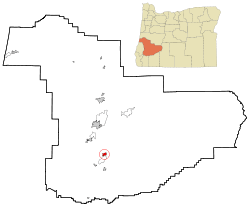Myrtle Creek, Oregon
Myrtle Creek is a city in Douglas County, Oregon, United States. The population was 3,439 at the 2010 census. It is the birthplace of U.S. Senator Jeff Merkley.[5]
Myrtle Creek, Oregon | |
|---|---|
 A hotel in Myrtle Creek | |
| Nickname(s): Gateway to the 100 Valleys of the Umpqua | |
 Location in Oregon | |
| Coordinates: 43°1′37″N 123°16′56″W | |
| Country | United States |
| State | Oregon |
| County | Douglas |
| Incorporated | 1893 |
| Government | |
| • Mayor | Matthew Hald |
| Area | |
| • Total | 2.50 sq mi (6.47 km2) |
| • Land | 2.50 sq mi (6.47 km2) |
| • Water | 0.00 sq mi (0.00 km2) |
| Elevation | 660 ft (200 m) |
| Population | |
| • Total | 3,439 |
| • Estimate (2019)[3] | 3,483 |
| • Density | 1,394.32/sq mi (538.40/km2) |
| Time zone | UTC-8 (Pacific) |
| • Summer (DST) | UTC-7 (Pacific) |
| ZIP code | 97457 |
| Area code(s) | 541 |
| FIPS code | 41-50950[2] |
| GNIS feature ID | 1124576[4] |
| Website | cityofmyrtlecreek |
History
Myrtle Creek was named for the groves of Oregon myrtle (also known as California laurel), growing nearby. A Myrtle Creek post office was established in 1854 with Lazarus Wright as postmaster. In 1862, Wright sold the land for a town site to John Hall, who laid out Myrtle Creek in 1865.[6]
The city has two covered bridges. The first, Neal Lane Bridge, carries Neal Lane Road over South Myrtle Creek on the southeastern outskirts of the city. It was built in 1939. At 42 feet (13 m) long, it is one of the shortest covered bridges in Oregon and the only one with a kingpost truss.[7]
In 1990, the City of Myrtle Creek acquired timbers from the former Horse Creek Bridge in Lane County and used them to build another covered bridge over Myrtle Creek. The bridge connects a parking area to the city's Mill Site Park.[8]
Geography
Myrtle Creek lies along Interstate 5 south of Roseburg and slightly north of Tri City and Canyonville in southern Douglas County.[9] Two streams, North Myrtle Creek and South Myrtle Creek, merge at the city to form Myrtle Creek, a short tributary of the South Umpqua River.[10]
According to the United States Census Bureau, the city has a total area of 2.51 square miles (6.50 km2), all of it land.[11]
Climate
This region experiences warm (but not hot) and dry summers, with no average monthly temperatures above 71.6 °F (22.0 °C). According to the Köppen Climate Classification system, Myrtle Creek has a warm-summer Mediterranean climate, abbreviated "Csb" on climate maps.[12]
Demographics
| Historical population | |||
|---|---|---|---|
| Census | Pop. | %± | |
| 1880 | 119 | — | |
| 1900 | 189 | — | |
| 1910 | 429 | 127.0% | |
| 1920 | 385 | −10.3% | |
| 1930 | 401 | 4.2% | |
| 1940 | 441 | 10.0% | |
| 1950 | 1,781 | 303.9% | |
| 1960 | 2,231 | 25.3% | |
| 1970 | 2,733 | 22.5% | |
| 1980 | 3,365 | 23.1% | |
| 1990 | 3,063 | −9.0% | |
| 2000 | 3,419 | 11.6% | |
| 2010 | 3,439 | 0.6% | |
| Est. 2019 | 3,483 | [3] | 1.3% |
| U.S. Decennial Census[13] | |||
2010 census
As of the census of 2010, there were 3,439 people, 1,382 households, and 930 families living in the city. The population density was 1,370.1 inhabitants per square mile (529.0/km2). There were 1,521 housing units at an average density of 606.0 per square mile (234.0/km2). The racial makeup of the city was 90.7% White, 0.3% African American, 2.1% Native American, 0.8% Asian, 0.1% Pacific Islander, 1.2% from other races, and 4.9% from two or more races. Hispanic or Latino of any race were 4.3% of the population.[2]
There were 1,382 households, of which 31.2% had children under the age of 18 living with them, 47.5% were married couples living together, 14.3% had a female householder with no husband present, 5.6% had a male householder with no wife present, and 32.7% were non-families. 26.4% of all households were made up of individuals, and 13.7% had someone living alone who was 65 years of age or older. The average household size was 2.46 and the average family size was 2.92.[2]
The median age in the city was 40.5 years. 23.3% of residents were under the age of 18; 8.4% were between the ages of 18 and 24; 24.2% were from 25 to 44; 26.6% were from 45 to 64; and 17.7% were 65 years of age or older. The gender makeup of the city was 49.1% male and 50.9% female.[2]
2000 census
As of the census of 2000, there were 3,419 people, 1,339 households, and 914 families living in the city. The population density was 1,952.5 people per square mile (754.3/km2). There were 1,437 housing units at an average density of 820.6 per square mile (317.0/km2). The racial makeup of the city was 93.45% White, 0.15% African American, 2.14% Native American, 0.88% Asian, 0.67% from other races, and 2.72% from two or more races. Hispanic or Latino of any race were 3.07% of the population.[2]
There were 1,339 households, out of which 34.0% had children under the age of 18 living with them, 50.9% were married couples living together, 12.6% had a female householder with no husband present, and 31.7% were non-families. 26.0% of all households were made up of individuals, and 12.5% had someone living alone who was 65 years of age or older. The average household size was 2.55 and the average family size was 3.06.[2]
In the city, the population was spread out, with 28.5% under the age of 18, 8.7% from 18 to 24, 25.7% from 25 to 44, 22.3% from 45 to 64, and 14.8% who were 65 years of age or older. The median age was 36 years. For every 100 females, there were 91.9 males. For every 100 females age 18 and over, there were 84.1 males.[2]
The median income for a household in the city was $30,658, and the median income for a family was $40,000. Males had a median income of $30,559 versus $22,102 for females. The per capita income for the city was $14,813. About 14.4% of families and 17.4% of the population were below the poverty line, including 26.9% of those under age 18 and 13.5% of those age 65 or over.[2]
Transportation
References
- "2019 U.S. Gazetteer Files". United States Census Bureau. Retrieved July 28, 2020.
- "U.S. Census website". United States Census Bureau. Retrieved December 21, 2012.
- "Population and Housing Unit Estimates". United States Census Bureau. May 24, 2020. Retrieved May 27, 2020.
- "US Board on Geographic Names". United States Geological Survey. October 25, 2007. Retrieved January 31, 2008.
- "Jeff Merkley (D)". The U.S. Congress Votes Database. Washingtonpost.com. Retrieved February 16, 2015.
- McArthur, Lewis A.; Lewis L. McArthur (2003) [1928]. Oregon Geographic Names (7th ed.). Portland, Oregon: Oregon Historical Society Press. pp. 687–88. ISBN 0-87595-277-1.
- Smith, Dwight A.; Norman, James B.; Dykman, Pieter T. (1989) [1986]. Historic Highway Bridges of Oregon (2nd ed.). Portland: Oregon Historical Society Press. p. 84. ISBN 0-87595-205-4.
- "Myrtle Creek (Horse Creek) Covered Bridge" (PDF). Oregon Department of Transportation. Retrieved February 17, 2016.
- Oregon Atlas & Gazetteer (7th ed.). Yarmouth, Maine: DeLorme. 2008. p. 53. ISBN 978-0-89933-347-2.
- "Topographic Map". United States Geological Survey. Retrieved May 12, 2015 – via ACME Labs.
- "US Gazetteer files 2010". United States Census Bureau. Archived from the original on February 20, 2011. Retrieved December 21, 2012.
- "Myrtle Creek, Oregon". Weatherbase. CantyMedia. Retrieved March 24, 2016.
- "Census of Population and Housing". Census.gov. Retrieved June 4, 2015.
External links
| Wikimedia Commons has media related to Myrtle Creek, Oregon. |
